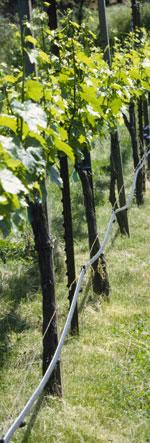Vineyard Irrigation
California Vineyards Prepare for 2021 Drought Conditions, UC and Lodi Growers Hold Water Management Workshops - excellent write up plus link to workshop videos.
Vineyard Irrigation with a Limited Supply of Water (YouTube) with Glenn McGourty, UC Cooperative Extension advisor in Mendocino and Lake counties, 2014.
Irrigation Scheduling
Delaying the initial irrigation of a season is a very effective method of water conservation. However, vines are very susceptible to water stress early season and leaf water potential must be monitored frequently to effectively schedule the initial irrigation in a season
Determining Vineyard Irrigation Requirements
Historical evapotranspiration data from CIMIS (California Irrigation Management Information System) stations may be used to approximate vine water demand over a given time period. This page describes how to calculate the number of hours to irrigate, based on historical or predicted evapotranspiration values.

Historical evapotranspiration (ET) data may be combined with current-year data to provide a very accurate model of vine water demand. A Microsoft Excel irrigation scheduling worksheet is available to determine the number of hours per week to irrigate a vineyard based on current and historical ET data, deficit irrigation strategy, stored soil moisture and in-season rainfall. Irrigation times are estimated using historical ET data, and adjusted using current-year ET data and the actual ammount of water applied from the previous week.
Deficit Irrigation of Quality Winegrapes Using Micro-Irrigation Techniques
This publication by UC Irrigation and Water Management Specialist Terry Prichard et. al. describes the many variables to be considered when scheduling winegrape irrigations.
Drip System Evaluation - Emission Uniformity Determination
Each drip emitter in a vineyard discharges water at a different rate due to manufacturing variation between emitters, pressure differences in the system, and emitter clogging. This variation within a drip system causes some areas to be over-watered and others to be under-watered. Emitters throughout a vineyard irrigation block are sampled, and that data is used to calculate emission uniformity.
Calculating Emission Uniformity to Adjust Irrigation Time
Emission uniformity is a measure of emitter variability and is used to adjust irrigation requirements and ensure the majority of vines receive the desired quantity of water. Emission uniformity values also indicate if repairs are needed to an irrigation system. This page describes how to calculate emission uniformity after the actual discharge of emitters in the vineyard has been sampled.
Emission Uniformity Calculator Excel Worksheet
To simplify calculation of emission uniformity, a bilingual emission uniformity Microsoft Excel worksheet is available. Discharge from emitters throughout the vineyard is sampled and values are entered into the worksheet for automatic calculation.

